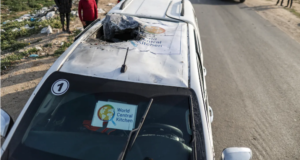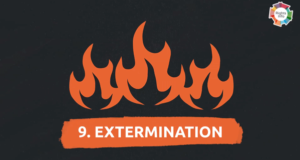International Solidarity Movement
20 June 2010

Israeli snipers arriving in jeeps
On Saturday, the unarmed workers began harvesting at 7am, accompanied by four international activists and several media agencies. The women worked roughly 150-200 meters from the Israeli border. After only thirty minutes, Israeli snipers began shooting around the plainly non-threatening group. Over fifty rounds were fired as international activists communicated the nonviolent nature of the harvest over a megaphone. The attack was more threatening than the opening barrages of previous mornings, putting the workers on edge
After the shooting ended, the group waited in the field until 8:15am, then moved further back to wait for the snipers and jeeps to retreat, like they usually do. At 9:00am, the jeeps were still stationed at the border. The severity of the attack, combined with earlier perilous situations, left the impression that someone would soon be intentionally shot, as is often the case. Consequently, the women were forced to leave the wheat unharvested. A sizeable amount remains in the ‘buffer zone’, highlighting the effect that this particular Israeli policy has on poverty and malnutrition in Gaza.

Women hand-harvesting wheat in the Gaza 'buffer zone'
Concern is expressed among farmers that if land in the ‘buffer zone’ (more than 30% of arable land) is allowed to lie fallow, Israel will seize the wide swath, claiming it is unused. This technique is commonly used in the West Bank, where settlements and the illegal annexation wall prevent farmers from accessing their land or expose them to violence. The land is then claimed because it has not been farmed.
Rubble collectors attacked, injured by artillery shelling near Beit Hanoun
Three rubble collectors were injured Saturday by artillery shelling near the northern city of Beit Hanoun as they collected concrete in the Gaza ‘buffer zone’. This is the second artillery attack in recent weeks. The previous, 27 May, left six farmers seriously injured.
Those venturing to the border regions to gather rubble and steel risk being shot with live ammunition and other weaponry as well as abduction. The Israeli military routinely raids the homes of rubble collectors to make arrests. Persons choosing to assume these risks do so as a result of the siege on Gaza which, along with Israel’s 23 day winter war, has decimated Gaza’s economy. Prior to the brutal assault, 98% of industrial operations were stagnant due to the blockade. The offensive then destroyed or severely damaged some 700 private businesses in just three weeks.¹
The recycled construction materials are vital in Gaza where the Israeli-led, internationally-complicit siege bans all but roughly 35 categories of items from entering. The list of banned construction materials includes cement, steel, glass, and plastic and metal pipes. Over 6,400 houses were destroyed or severely damaged in the Israeli war on Gaza, and nearly 53,000 sustained lesser damages. Hospitals and medical centres, schools, kindergartens and mosques are among the other buildings destroyed and damaged. Since the war, a monthly average of four trucks now reach Gaza with construction materials, less than .05% of the pre-siege levels. ¹
Gaza ‘buffer zone’ background
While unemployment levels hover near 42% in Gaza and 60% of its 1.5 million residents lack food security, ² Israel’s illegal buffer zone greatly exacerbates the humanitarian crisis. 30% of Gaza’s arable farmland, and some of its most fertile, lies within the buffer zone. ³ Farmers who attempt to work in the zone face live fire and crop destruction. The number of crops grown in the zone has consequently been reduced from a diverse range to wheat and other less labor-intensive harvests, which further negatively impacts the nutrition and economic condition of Gazans. An additional 17% of farmland was destroyed in Israel’s war of aggression,¹ making 47% (nearly half) of Gaza’s farmland now marginally usable.
The buffer zone has also reduced Gaza’s fishing zones to 1-3 miles offshore. In the first four months of 2010, 19 naval attacks led to two shootings and three arrests, as well as numerous confiscations of fishing equipment. The narrow fishing zone, in which over 3,600 fishermen work daily, is gravely over-fished. ³
Israel’s decision to instate a 300-meter buffer zone is in violation of Oslo Accords, and people are routinely shot as far as two kilometers from the border. Israeli attacks in the buffer zone injured 50 persons and killed 14 between January and April 2010. In the past twelve months, at least 220 Israeli attacks have been carried out, with 116 coming since the beginning of 2010 (as of April 30th). ³
¹ Oxfam: Failing Gaza: No rebuilding, no recovery, no more excuses
² PCHR Fact Sheet: The Illegal Closure of the Gaza Strip
³ PCHR Fact Sheet: The Buffer Zone in the Gaza Strip
 International Solidarity Movement Nonviolence. Justice. Freedom.
International Solidarity Movement Nonviolence. Justice. Freedom.


